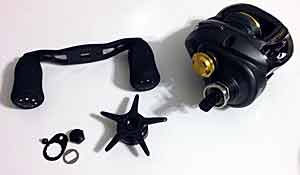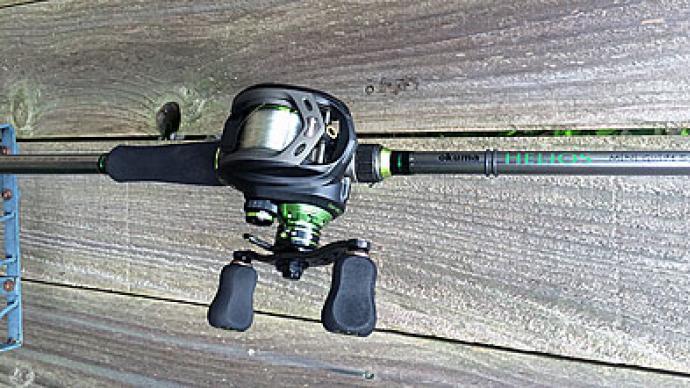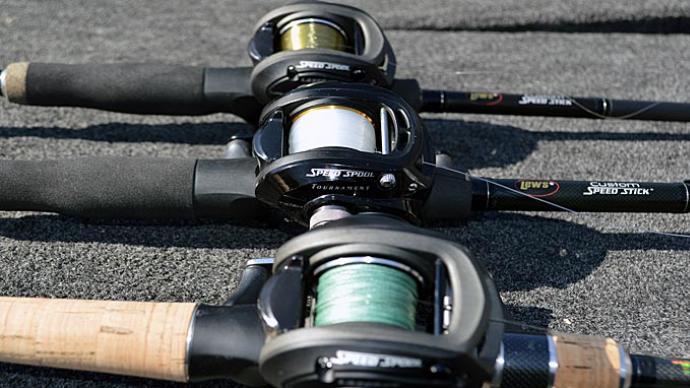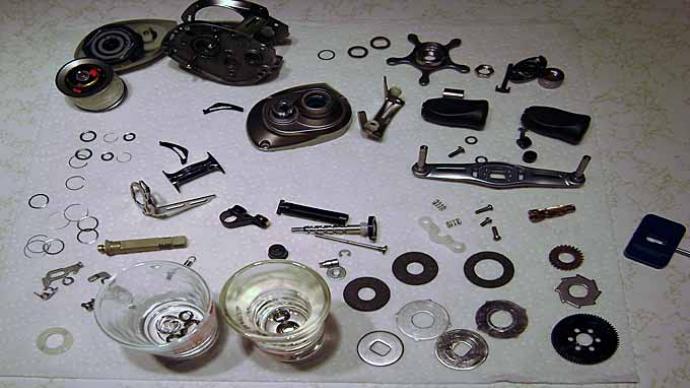
Nowadays, anglers are interested in cleaning and maintaining their reels, changing out bearings, jazzing up the gears, and constantly pushing their reels to the edge of design. I hope you will find the following information interesting and beneficial in your quest to have a perfect fishing reel.
Anti-Reverse
This part stops the handle from turning backward. It is either one of two types. The older reels have an anti-reverse mounted on a frame post, has two claws and must be straddled over the drive shaft ratchet. The other type is called an Instant Anti-reverse and is mounted on the right-hand side plate.
ABEC (Annular Bearing Engineering Committee)
Bearing manufacturers design and manufacture their bearings to meet this standard. The number following the ABEC indicates the tolerance of the bearing. The higher the number, the tighter the tolerance. All reel manufacturers have Precision Miniature Bearings in their reels.
Bearing Clip Removal
These are the retaining clips that hold bearings in place. Usually Octagon shaped. Removing a clip is relatively simple. First, put your forefinger over the bearing clip, use a pair of tweezers, and grab hold of the clip. Next, slide the tweezer ends toward the clip end and pull the end of the clip in and lift out the clip. All the while, you are keeping your forefinger over the clip. Be careful. They sometimes take on a life of their own.
Bearing Clip Installation
The same principle applies. Put your forefinger over the bearing cavity. Using tweezers, install the back of the bearing clip and one side, then slide the tweezer up towards the free end of the clip, pull in, and push down. It's a done deal!
Bearing Removal
Unfold a paper clip, and bend one end at a right angle. Now, you have a bearing puller. Insert the right angle inside the bearing and lift out. Paper clip makes a great tool.
Bearing Installation
Position bearing over bearing cavity. Using the forefinger, apply even pressure to seat the bearing. Never hit or use heavy force on the seat bearing. The tolerance between the outside of the bearing and the inside of the bearing cavity is close.
Bearing Maintenance
Cleanliness and care of bearings are essential. Clean bearings in a bottle cap with Lighter fluid or Acetone in it. Swish bearings around until clean. Air dry on a towel. Spin on the end of a screwdriver to ensure they are spinning freely. Apply one drop of oil per bearing.
Chemicals
It is not a good idea to use chemicals on reels, which is why...The use of harsh chemicals such as gasoline on plastic parts in reels may not show up until later. In addition, the chemicals can corrode parts. Therefore, a bio-degradable cleaner is highly recommended to clean reels and parts.
Copper Insulators
These are located in the left side plate of a reel and inside the Cast Control Cap. They may be round or rectangular. From time to time, they will get dented due to the tightening of the Cast Control Cap, causing the spool shaft ends to indent the insulator. Check them and turn them over, so the smooth side will contact the spool shaft ends.
Curved Washers
They are called Drag Spring Washers. These two washers should always be mounted ( ), one curved up and one curved down. This is necessary for compression when tightening the star drag under the handle.
E Clips
These clips are shaped like an E. Remove them by positioning your forefinger over them. Then, insert the tip of the open tweezer into the back of the E, and pull out just a tad until you can grab hold of the clip completely to remove it. Be sure to hold your finger over the clip until you get a good bite on it with tweezers. I don't want you to wear out knees or britches crawling around on the floor looking for those little suckers! Been there and done that!
Grease
The application of reel grease is essential. The grease should be applied at the base of the gear teeth so that when the teeth of the gears mesh together, the grease is being used as intended. Wiping the outside of gears with grease will cause the grease to splatter inside of the reel, and all is lost. A grease with a good temperature rating is preferred. Never use Vaseline.
Line Guide
It is the piece at the front of the reel with an eyelet that line is threaded from the reel spool to the rod. The line guide travels back and forth on the worm gear. It holds the line guide pawl.
Line Guide Pawl
This small piece is mounted in the cavity on the line guide and held in place by a cap. The pawl travels between the flattened teeth of the worm gear. If the pawl is hanging up or stopping on one side of the reel, please remove it and look it over. Examine the sides looking for scratches and gouges. The tips will be worn and not sharply pointed. The worm gear may have burrs or scratches also on the flattened teeth. Generally, it is a good idea to replace both simultaneously.
Line Slipping
Sometimes braided line will slip on the spool even though the drag is tightened down. The solution to this problem is to spool at least 10-15 yards of monofilament line next to the spool arbor, then tie the braided line to the monofilament.
Oil
Rocket Fuel oil is available in three viscosities. The Tournament is very thin, used chiefly by anglers in Casting Contests, and must be applied frequently. Next is the Yellow, which is of medium viscosity and is used by most anglers. It can be applied less often, Probably twice a season, depending on how much reel is used. The last oil is the Red, the thickest, and is used by anglers wanting to slow down their reel.
Rocket Fuel possesses slightly adhesive qualities at the start of the cast yet is free running at the end of the cast. It will not evaporate so that the reel bearings will not film over or have the oil in them turn into sludge. The oil will not mix with water and has a wide temperature range. It is not affected by any normal temperature differences, and due to its slightly adhesive qualities, it will not easily be thrown off.
ReelX
Corrosion Technologies make this product. It is a new, high-tech, extreme-pressure lubricant that stops and prevents wear, corrosion, or rust. It contains no wax, tar, silicone, or other solids, so it can't gum up. It outperforms all other lubricants, displaces moisture, and won't harm monofilament line.
Quantum Hot Sauce
This oil is the new kid on the block! Working with lubrication specialists, the engineers developed their lubrication called Quantum Hot Sauce. It has some very unique properties not found in ordinary reel oils. For example, its low viscosity allows for a highly free rotation of the crank handle and a lightning-fast Free Spool that may scare you. In addition, special additives cause the lubricant to bond molecularly with the base metal providing superior corrosion protection and a lubrication bond that remains--permanently.
Pinion
The pinion sets down on the spool shaft as the handle is turned in the retrieve mode. If retrieve is started before the lure landing, the pinion doesn't get a chance to sit on the spool shaft. After a period of time, there will be a clatter click, which is the pinion trying to sit on the spool shaft. The pinion stops the spool rotation. If the pinion is not seated, the fish will be hauling off, and you probably can't turn or stop the getaway.
Reel Cleaning
Cleaning a reel is easier and more manageable than one might think. Use a bio-degradable cleaner and an old cake pan, or your wife's new one will be fine.
Lay out strips of tape (masking tape will do) on the table and write numbers on tape every 2 inches or so. As you remove a part, lay it by the number. For instance, the first thing removed should be the nut cap screw on the handle nut cap. Lay the screw on number one, lay the nut cap on number 2, and lay the handle nut on 3. Continue until all parts are removed. To re-install parts, start with the highest number until the last part is mounted, which is the nut cap screw laying on the number one. Jot down the part's orientation on paper if you don't have a schematic. I tell all anglers to orient the reel the same way each time it is picked up. Doing this allows you to install parts correctly and will eliminate the confusion of part installation.
Smoooooth Drag Washers
These drag washers are comprised of high-density fiber material and silicone. The fiber draws off the heat rapidly, and the silicone lubricates materials that reach very high temperatures. These drag washers require no grease.




